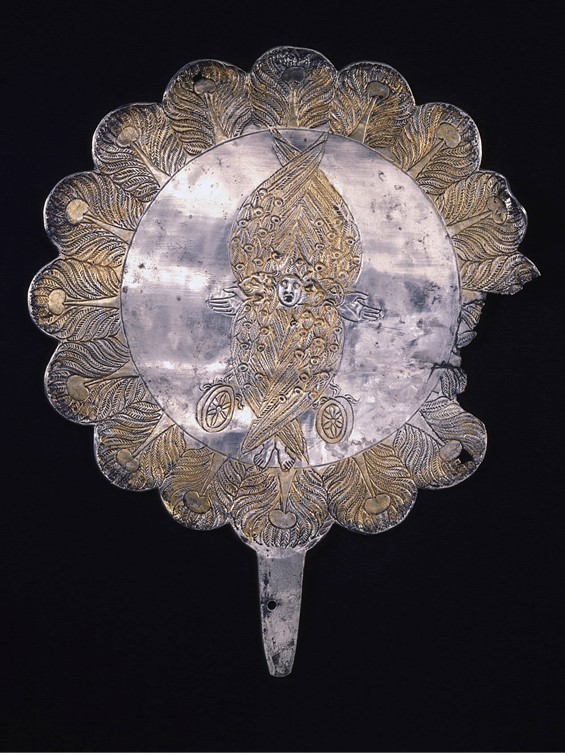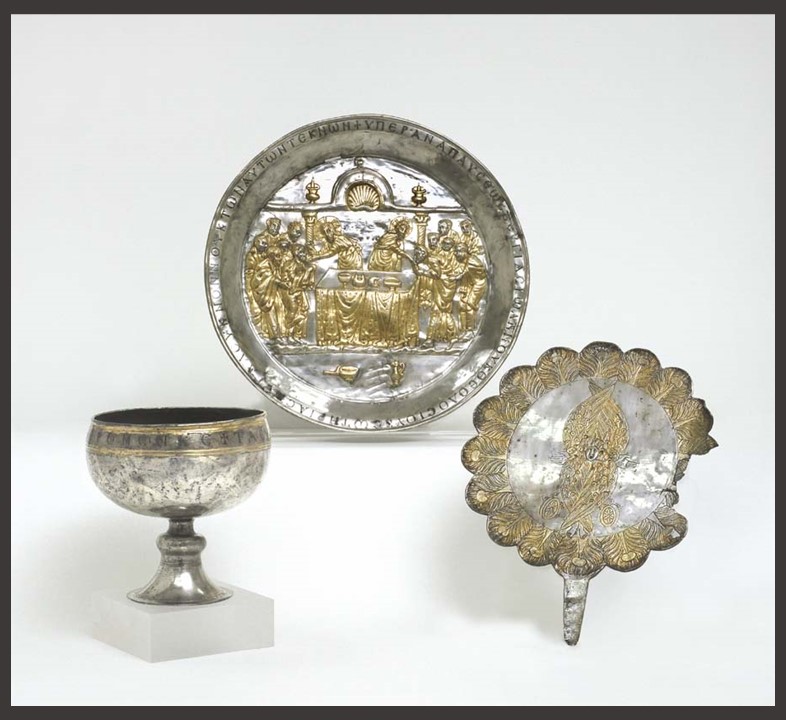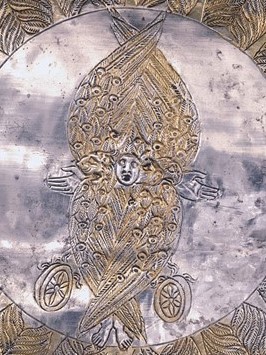
A flabellum (plural flabella), in Christian liturgical use, is a fan, made of metal, leather, silk, parchment, or feathers, intended to keep away insects from the consecrated Body and Blood of Christ and from the priest, as well as to show honour. The Apostolic Constitutions, a work of the fourth century, state (VIII, 12): “Let two of the deacons, on each side of the altar, hold a fan, made up of thin membranes, or of the feathers of the peacock, or of fine cloth, and let them silently drive away the small animals that fly about, that they may not come near to the cups.”. The 6th century Silver Flabellum in the Collection of the Dumbarton Oaks is not only liturgical but a work of great art as well! https://en.wikipedia.org/wiki/Flabellum
The Bliss-Tyler Correspondence, always fascinating, provides two references to the purchase of the Silver Flabellum/ Rhipidion (in Greek)/Fan of the Dumbarton Oaks Collection by Robert Woods Bliss in 1936, in Paris, France. The first reference is made in a letter dated February 1, 1936… I’m much excited about your recent acquisitions. Hurrah for the Drey cross! And for the Rhipidion (fan). And I’m prepared to enthuse about the pyx when I see it or a photo. The second reference is dated March 6, 1936… The rhipidion (flabellum) is certainly early VIe cent. The hallmarks make that certain, and the style is perfectly consistent. https://www.doaks.org/resources/bliss-tyler-correspondence/letters/01feb1936 and https://www.doaks.org/resources/bliss-tyler-correspondence/letters/06mar1936

During the turbulent years (7th century) of the Sasanian and then the Arab invasions of Syria, devoted Christians buried a precious collection of liturgical vessels for safekeeping, hoping they will be able to reclaim them when peace would have prevailed. The silver Rhipidion, along with an amazing Paten and a Chalice, all three of them in the Dumbarton Oaks Collection today, were discovered at Riha, a small village south of Aleppo in central Syria. It has been written by Stephen Zwirn of the Dumbarton Oaks, that the Riha Treasure along with silver treasures from nearby Stuma, Hama, and Antioch were discovered at about the same time, and it has been suggested that these hoards actually constituted one large group brought together for protective burial, which was divided into smaller sets after it was unearthed early in the twentieth century. The original owners never came back to retrieve their treasures… and thus, many centuries later, they ended up in different Museums and private collections around the world! http://museum.doaks.org/objects-1/info/27007http://museum.doaks.org/objects-1/info/27007 and https://www.doaks.org/resources/bliss-tyler-correspondence/annotations/silver-treasure
The Riha chalice, paten, and fan were each impressed, writes Stephen Zwirn, with stamps that indicate the emperor’s reign during which they were made. The chalice was fabricated during the reign of Justinian I (527–65), while the paten and fan belong to the reign of his successor, Justin II (565–78)… They form a set for use in the Orthodox Eucharist, or Communion: the paten held the leavened bread, still a tradition in Orthodox worship, the chalice contained the wine, and the fan was used to keep insects away from the bread and the wine. It has been suggested that they were produced in Constantinople and purchased by Megalos and Nonnous, a couple named in the inscription of the paten, for presentation to a church in Syria soon after 577. http://museum.doaks.org/objects-1/info/27007 and file:///C:/Users/aspil/OneDrive/Blog/Byzantium/Age_of_Spirituality_Late_Antique_and_Early_Christian_Art_Third_to_Seventh_Century.pdf pages 617-18

The silver Flabellun/Rhipidion/Fan in the Dumbarton Oaks is engraved with sixteen peacock feathers around its scalloped rim. On its central disk, the 6th-century silversmith, engraved a tetramorph cherubim, the four-winged creature described in Ezekiel 1:4–21. The same tetramorph has been, summarily, engraved on the reverse side as well. The luxury of all liturgical vessels discovered in Syria indicates the splendor of the Early Christian Church Service, and the magnificent silver Rhipidion in particular, the ceremonial status altar fan had during the Orthodox Eucharist or Communion Service. file:///C:/Users/aspil/OneDrive/Blog/Byzantium/Age_of_Spirituality_Late_Antique_and_Early_Christian_Art_Third_to_Seventh_Century.pdf pages 617-18
For a Student Activity inspired by the Silver Flabellum in the Collection of the Dumbarton Oaks, please… Check HERE!